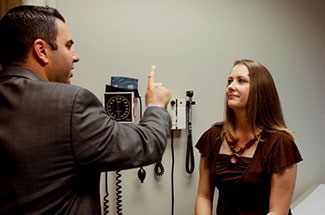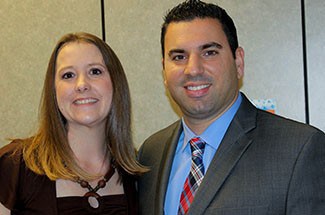UAMS Performs First Heart-Stopping Surgery to Repair Aneurysm
| Ashley Bell’s heart stopped beating while she was on the operating table. But that was exactly what her doctors intended.

Adib Abla, M.D. examines patient Ashley Bell during a checkup weeks after her brain surgery.
She is the first patient in at UAMS and likely the entire state to undergo Adenosine induced asystole in aneurysm surgery, a method that stops the heart and blood flow to an aneurysm, making it easier to close it off.
Bell had bilateral carotid artery aneurysms, called mirror aneurysms. They were pressing on the optic nerves behind both her eyes. She first noticed a significant change in her vision in July.
“I couldn’t see as clearly out of one eye, then the other. Then my right arm went numb,” Bell said. “At work one day, I was talking to a coworker and could hardly get my words out.”

Adib Abla, M.D. examines patient Ashley Bell during a checkup weeks after her brain surgery.
Bell visited her primary care physician in Jonesboro and was initially diagnosed with complex migraines (a migraine with neurologic symptoms). When medication did not alleviate her symptoms, Bell talked to a neurologist who ordered a computed tomography (CT) angiogram. The images showed two brain aneurysms.
“I was in shock,” Bell said. “They told me to go UAMS immediately. I came in through the emergency room.”
Adib Abla, M.D. is director of cerebrovascular surgery and neurovascular research in the UAMS College of Medicine Department of Neurosurgery. He talked to Bell about her treatment options and the risks involved.
“There was concern I could lose my vision,” Bell said. “I told him I did not care. Just do whatever you can to keep me alive for my babies.”
“Based on the pressure the aneurysms were putting on her optic nerves, she decided to have surgery,” Abla said. “We started on her left side the next morning. She recovered very nicely after the first surgery.”
Her first surgery lasted four hours in the operating room and in October, two months later, Bell had another four-hour surgery, this time on her right side. That’s the side where Abla needed to stop her heart to effectively clip the aneurysm. Since it was so close to her optic nerve, the risk of blindness in the procedure was estimated to be 5 percent.
“Too much manipulation would have increased her chances of going blind.” Abla said. “Deflating the aneurysm made it easier to clip with less manipulation of the optic nerve.”

Ashley Bell, a patient who had mirror aneurysms poses with UAMS neurosurgeon Adib Abla, M.D.
Stopping and starting the heart successfully would not be possible without a neuroanesthesiologist keeping a close eye on the patient’s vital signs while under temporary cardiac arrest.
“Our colleagues in neuroanesthesiology are pivotal in doing this type of procedure,” Abla said. “They watch the EKG closely and bring her heart back to beating normally if the medication doesn’t wear off the way it should. But in Ashley’s case, it wore off nicely.”
Using Adenosine, a building block of DNA, Indranil Chakraborty, M.D., associate professor in the Division of Neuroanesthesiology in the College of Medicine would stop the patient’s heart for 20 seconds at a time.
That time frame, Abla said, was enough for him to put a clip on the aneurysm itself. Closing the blood vessel that supplies the aneurysm is another option but in this case would have required making another incision lower down in the neck region.
“The aneurysm and the vessel that feeds it are both at the base of the skull,” Abla said. “We would have had to make another incision and opening in her neck to clip the blood vessel supplying the aneurysm.”
Before using Adenosine to stop the heart for aneurysm clipping, there were two other ways doctors used to treat aneurysms that were difficult to deflate. One way was to make a second incision in the neck, as is done sometimes for carotid artery aneurysms. This is still commonly done.
The other way, as was the case for basilar artery aneurysms, put the patient under hypothermic circulatory arrest, bringing the body temperature to less than 85 degrees Fahrenheit and stopping the heart for 45 to 60 minutes. That procedure is no longer practiced for cerebral aneurysms because of the risks involved, Abla said.
“I was really impressed with the care I received from my doctors and staff,” Bell said. “I was nervous and scared. When I think of aneurysms, I don’t hear about those who live through it. I’m grateful to still be here for my family.”